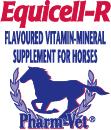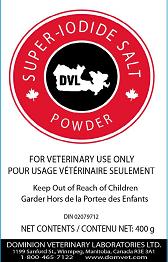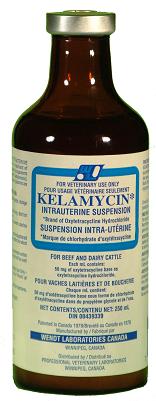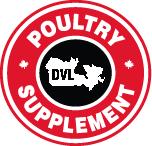|

THINGS GO BETTER WITH
PHARM-VET & DOMINION-VET
Pharm-Vet is a subsidiary of Dominion Veterinary Laboratories Ltd. Pharm-Vet consists of a complete line of horse products including vitamin feed supplements, drug formulations, accessories and instruments.
Pharm-Vet, founded in 1986, is located in Winnipeg, Manitoba, Canada. It is a family owned and operated company.
Pharm-Vet specializes in developing, marketing and distributing products for horses and large animals, serving the North American market and the world.
Pharm-Vet products are manufactured at Dominion Veterinary Laboratories' facility, which is a licensed GMP producer of veterinary pharmaceuticals for more than five decades, serving both the Canadian and International markets.
Pharm-Vet is proud to be a young Canadian company that succeeded in achieving both growth and profit in a short time through its integrated management, R&D, marketing and distribution approach.
Pharm-Vet products are formulated to meet the expectations of trainers, owners and riders. We not only provide our customers with the absolute best products and service, but we listen to them, respond quickly to their current needs, anticipate future needs, and earn their business every day.
Brief Account of Research Activity (R&D)
Pharm-Vet specializes in developing products for horses and large animals. These products are manufactured at Dominion Veterinary Laboratories' GMP facility; both companies are located at 800 Main Street, Winnipeg, Manitoba, Canada.
Pharm-Vet uses only high quality ingredients obtained from the best Canadian sources. All ingredients are tested before and after entering the plant to ensure purity and compliance with the high standards of the Canadian government.
Our quality assurance and manufacturing excellence through strict control systems guarantees the level of quality of the finished product throughout the production process. Finished products are tested for environmental conditions to keep maximum shelf live with high potency.
Through company specialists we determine the substance that we use in our products to enhance the horse's ability to build muscles, increase speed and resist stress. We endeavor to maximize the horse's physical performance by discovering their specific nutritional needs.
Our products are available in different forms; powders, liquids, granules, and pellets. Our packaging material, not only durable and attractive, but is customized to the customers needs while keeping the freshness guaranteed.
Equicell-R Liquid

Flavoured Vitamin-Mineral Supplement for Horses
Feed Act Registration No.: 820240
INGREDIENTS: Biotin, Choline Chloride, Folic Acid, Menadione Sodium Bisulfite Complex, Niacin, Pantothenic Acid, Pyridoxine Hydrochloride, Riboflavin, Thiamine Hydrochloride, Vitamin A, Vitamin B12, Vitamin D3, Vitamin E, Methionine, Lysine, Cherry Flavour (Reg. No. 981173), Citric Acid, Cobalt Sulfate, Copper Sulfate, Cane Sugar, Dextrose, Ethoxyquin, Ferric Ammonium Citrate, F.D. & C. Red #2, F.D. & C. Yellow #5, Magnesium Sulfate, Manganese Sulfate, Potassium Chloride, Potassium Sorbate, Sodium Benzoate, Sodium Selenite, Xanthan Gum, Zinc Sulfate and Water.
This feed contains added Selenium at 8 mg/kg.
GUARANTEED ANALYSIS PER KG:
Vitamin A (min.) 1,190,000 IU
Vitamin D3 (min.) 259,000 IU
Vitamin E (min.) 1,530 IU
Vitamin B12 (min.) 6,000 mcg
Thiamine (min.) 3,400 mg
Riboflavin (min.) 950 mg
Pyridoxine (min.) 340 mg
Menadione (min.) 85 mg
Niacin (min.) 9,180 mg
Folic Acid (min.) 340 mg
Biotin (min.) 0.800 mcg
Choline (min.) 7,820 mg
Pantothenic Acid (min.) 1,700 mg
Iron (actual) 9,500 mg
Copper (actual) 900 mg
Cobalt (actual) 130 mg
Zinc (actual) 3,400 mg
FEEDING DIRECTIONS: HORSES IN TRAINING OR RACING: Feed 60 mL of Equicell-R daily. HORSES NOT IN TRAINING: Feed 30 mL of Equicell-R daily. Feed Equicell-R by mixing into daily ration. Directions for use must be carefully followed.
STORE IN A COOL, DARK PLACE. KEEP FROM FREEZING. CLOSE CONTAINER AFTER USING. AGITATE WELL BEFORE FEEDING. KEEP OUT OF REACH OF CHILDREN. HARMFUL OR FATAL IF SWALLOWED.
PRESENTATION/PACKING: 4 Litre jug; 4 jugs/carton.
EQUICELL-R is a liquid feed supplement for horses, fortified with iron, and formulated to provide supplemental vitamins and minerals which may be lacking in the horse’s normal feed.
PleaseClick Here to Order. Thank you for visiting Domvet.com.
TOLNOXEQUINE

THRUSH TREATMENT
1% w/w Tolnaftate Cream
Topical Treatment of Thrush in Horses
Tolnoxequine Thrush Treatment is a clean, pleasant smelling cream that applies easily to effectively treat occasional and recurring thrush conditions without sticky messes, stains, or spills.
INDICATIONS:
For Treatment of Thrush in Horses.
DIRECTIONS:
Clean the sole and frog of the hoof to remove all dirt and dead tissue. Deposit a layer of cream as it is expressed from the tube, approximately ¼ inch in thickness, along the sulci of the frog. Apply a light wrap or bandage if necessary to keep the cream on the foot.
Repeat the cleaning and applications daily for ten days.
CAUTION:
If the condition worsens or persists beyond 10 days, consult a veterinarian.
FOR EXTERNAL USE ONLY.
WARNING:
Keep out of the reach of children.
This drug is not to be administered to horses that are to be slaughtered for food.
ACTIVE INGREDIENT:
1% w/w Tolnaftate.
STORAGE:
Store at Room Temperature.
NET CONTENTS:
50 g syringe.
PleaseClick Here to Order. Thank you for visiting Domvet.com.
Disclaimer: Every effort has been made to ensure the accuracy of the information published. However, it remains the responsibility of the readers to familiarize themselves with the product information contained on the product label or package insert. NAC No.: 11810832
SUPER-IODIDE SALT
Feed Supplement
Indications:
For use in cattle as a feed supplement for iodine deficiencies, an expectorant, and as an aid in the treatment of infertility.
Directions:
Feed Supplement: Feed continuously 50 mg EDDI (0.5 grams powder) per head per day. (200-400 g powder/tonne feed).
Expectorant: Administer orally 650-1300 mg EDDI (6.2-12.4 grams powder) per head twice daily for 7 days.
Infertility: Administer orally 1300 mg EDDI (12.4 grams powder) per head twice daily for 7 days.
Caution:
Until iodine tolerance is determined, administer this product with caution. Higher intake may cause intestinal disorders. In case of iodism, discontinue treatment. Signs include: increased salivation, sneezing, eye irritation, and swelling of eye lids. Animals recover after iodides are withdrawn.
Active Ingredient:
Each 400 grams contains:
42 g EDDI (ethylenediamine dihydroiodide) in a salt base.
This is equivalent to 105 mg/g of EDDI.
Keep Out Of Sunlight
Keep Out Of Reach Of Children
DIN 02079712
PleaseClick Here to Order. Thank you for visiting Domvet.com.
KELAMYCIN
INTRAUTERINE SUSPENSION
KELAMYCIN INTRAUTERINE SUSPENSION is a yellow, homogeneous, stable suspension of oxytetracycline hydrochloride for intrauterine infusion. Each mL contains 50 mg of oxytetracycline base in propylene glycol and water. This preparation will not freeze at temperatures as low as -34º C and in addition, under normal storage conditions (room temperature), there is very little settling observed. This preparation may darken on standing but the potency remains unaffected.
Indications:
KELAMYCIN INTRAUTERINE SUSPENSION is indicated for the treatment of metritis in beef and dairy cows caused by organisms such as E. coli, Streptococci, Bacilli, Staphylococci, Proteus, and Clostridia, when these organisms are sensitive to oxytetracycline. It is extremely important that an accurate diagnosis is made in order to determine an adequate course of treatment. Metritis may be diagnosed by rectal palpation following uterine discharges of abnormal color, e.g. red, brown, black, or discharges of abnormal viscosities thick or watery.
Directions:
The technique for infusion of antibiotics into the uterus of cattle is essentially the same method used for artificial insemination. This is performed by the operator inserting one hand and arm (encased in a rubber or plastic sleeve) into the rectum and grasping the cervix. The vulva and vulvar lips are carefully wiped or, if necessary, washed and then wiped dry with a paper towel. Precautions should be taken to make certain that no feces are wiped between the vulvar lips. An insemination pipette is inserted through the vulva and vagina and into the external os of the cervix. If the folds of the vaginal wall interfere, the cervix is pulled or pushed forward to straighten the lumen of the vagina. If the external os is hard to locate, the cervix may be held by the fingers and thumb placed over the external os. The pipette is manipulated to strike the thumb and then into the cervix. By a combination of gently inserting the pipette and working the cervix over the pipette, it is usually readily passed through the cervix and into the body of the uterus. Antibiotics can then be infused through the pipette and into the uterus.
weight of animal mL to administer
600 LB (272.2 KG) 21 TO 24 ML
800 LB (362.9 KG) 28 TO 32 ML
1000 LB (453.6 LB) 35 TO 40 ML
1200 LB (544.3 KG) 42 TO 48 ML
1500 LB (680.4 KG) 53 TO 60 ML
When properly used in the treatment of metritis caused by oxytetracycline susceptible organisms, most animals that have been treated with KELAMYCIN INTRAUTERINE SUSPENSION show a noticeable improvement within 24 to 28 hours. If improvement does not occur within this period of time, the diagnosis and course of treatment should be reevaluated. It is recommended that the diagnosis and treatment of diseased animals be carried out by a veterinarian. Since many diseases look alike but require different types of treatment, the use of professional veterinary and laboratory services can reduce treatment time, costs and needless losses. Good housing, sanitation and nutrition are important in the maintenance of healthy animals and are essential in the treatment of disease.
The infusion of KELAMYCIN INTRAUTERINE SUSPENSION must be carried out under aseptic conditions to avoid inserting pathogenic organisms into the uterus . Improper administration techniques will subject the patient to dangers of severe magnitude, e.g. uterine rupture, peritonitis, etc. The administration of KELAMYCIN INTRAUTERINE SUSPENSION following inaccurate diagnosis may cause an overgrowth of non-susceptible oxytetracycline organisms. This could result in metritis infections which would be resistant to this preparation. Pregnant animals may abort following inappropriate treatment with this drug.
Note:
1) To avoid contamination of other animals, use only one infusion pipette per animal. Do not reuse a pipette for infusion into another cow. Dispose of used pipette properly.
2) For ease of administration, KELAMYCIN INTRAUTERINE SUSPENSION should be warmed to body temperature (37º C).
3) If during administration an accidental spillage occurs, the patient may show signs of straining and distress. This may also occur if the drug is improperly placed into the vagina instead of the uterus. When properly administered, no sign of discomfort will be observed. Also, care should be taken to avoid deposition of this drug on the outside wall of the insemination pipette prior to administration.
Warning:
Treated animals must not be slaughtered for use in food for at least 18 days after the latest treatment with this drug.
Milk taken from treated animals within 24 hours after the latest treatment must not be used in food.
For Professional Veterinary Use Only. Not for Use in Humans. Keep Out of Reach of Children.
Caution:
For intrauterine infusion only. Not for intramuscular or intravenous use.
Presentation/packaging:
250 mL
Shake Well Before Using
DIN 00439339
PleaseClick Here to Order. Thank you for visiting Domvet.com.
Poultry Supplement
poultry-feed-supplement

DVL Poultry Supplement is a palatable liquid feed supplement for broilers formulated with essential vitamins and minerals. For use in the daily feed ration when additional amounts of vitamins and minerals are desired.
Feeding Directions:
Add 1 litre of DVL Poultry Supplement to every 3,000 litres drinking water.
This feed contains added Selenium at 28.7 mg/L
Guaranteed Analysis per Litre:
Vitamin A (min.) ......................................................... 833,333 IU
Vitamin D3 (min.) ....................................................... 116,667 IU
Thiamine (Vitamin B1) (min.) ....................................... 1,833 mg
Riboflavin (Vitamin B2) (min.) ......................................... 933 mg
Vitamin B12 (min.) ...................................................... 4,000 mcg
Folic Acid (min.) .............................................................. 333 mg
Choline Chloride (min.) ................................................ 7,667 mg
Potassium (actual) ....................................................... 3,333 mg
Sulfur (actual) ............................................................... 8,333 mg
Copper (actual) ............................................................ 1,467 mg
Magnesium (actual) ........................................................ 667 mg
Cobalt (actual) ................................................................... 67 mg
Ingredients:
Biotin, Choline Chloride, Folic Acid, Menadione Sodium Bisulfite Complex, Niacin, Pantothenic Acid, Pyridoxine Hydrochloride, Riboflavin, Thiamine Hydrochloride, Vitamin A, Vitamin B12, Vitamin D3, Vitamin E, Vanilla Flavour (Reg. No. 981306), Citric Acid, Cobalt Sulfate, Copper Sulfate, Cane Molasses, Corn Syrup, Ferric Ammonium Citrate, F.D. & C. Red #2, F.D. & C. Yellow #5, Magnesium Sulfate, Manganese Sulfate, Calcium Propionate, Benzyl Alcohol, Sodium Selenite, Zinc Sulfate, Sodium Saccharin, Potassium Iodide, Potassium Chloride, Ethoxylated Sorbitan Mono-oleate, Polysorbate 80, Lysine, Methionine, & Water.
Density of DVL Poultry Supplement at 20°C: 1.174 g/mL. This product must be agitated while being dispensed or fed. The viscosity of this product will vary inversely with temperature.
PleaseClick Here to Order. Thank you for visiting Domvet.com.
|
SAVE TIME & MONEY WITH LOWER PRICES

 Cattle Supplies Cattle Supplies |
 Horse Supplies Horse Supplies |
| |
|
 Poultry Supplies Poultry Supplies |
 Hog/Pig Supplies Hog/Pig Supplies |
| |
|
Click here to glance at our catalogue in Spanish.
Click here Equine Vitamin-Mineral Deficiency Chart.
Dominion Veterinary Laboratories guarantees you top quality made-in-Canada products. For instance, horse liniment, horse products, horse supplies, horse drugs, horse medications, horse supply, horse supplements, cattle supplies, livestock supplies, cattle medicine, cattle prod, cattle feed, cow supplies, livestock antibiotics, and horse medicine.
horse products Horse Liniments are common substances used by trainers and owners of horses. May be sponged on the body. Liniments are especially useful in hot weather to help a hot horse cool down. Alcohols help the product quickly evaporate, and the oils they contain cause the capillaries in the skin to dialate, increasing the cooling process.
Liniments should always be applied according to the manufacturer's directions, and diluted as necessary. Many horse owners apply liniments to the legs as a brace, and then wrap over it. In this case, they should be sure that the liniment is not too strong.
Liniments should not be applied to more sensitive areas such as the head, dock, or groin of the horse. The body may also be too sensitive to apply liniments if the horse was recently body-clipped.
Upper Respiratory Tract Abnormalities Laryngeal hemiplegia (LHP, also known as ‘Roarers’), Laryngopalatal dislocation (DDSP or Displaced soft palate), epiglottic entrapment (EE), abnormal alar folds (false nostril noise) and persistent lymphoid hyperplasia (PLH) are the most common conditions causing dynamic upper respiratory tract obstruction resulting in poor performance in horses. Examination of the horseCareful examination of the horse’s upper respiratory tract by endoscopy, assessment of respiratory noise made by the horse, either by observation on the racetrack or treadmill, thorough questioning of the rider as to the sequence of either loss of performance or commencement of any respiratory noise, are all important for a full clinical assessment.Almost all yearlings scoped for yearling sales exhibit some lymphoid hyperplasia. Its persistence beyond the breaking in period, early training and early 2-year-old racing, affects the young horse and may lead to the further development of soft palate problems.False nostril noise is common and not considered significant unless associated with poor performance. Surgery is indicated if positive improvement occurs with false nostril tie back. Recently, the use of stick-on nose bands appears to alleviate this problem. Inspiratory noisesInspiratory noises are associated with mechanical or functional interference to the upper airway, for example chondritis (inflammatory changes to the throat cartilages), and narrowing of the larynx (LHP). ‘Whistling’ or ‘roaring’ noises are heard on inspiration only, during fast exercise. Surgery can improve these conditions. Expiratory noises Expiratory noises, or gurgling sounds, can be very inconsistent but are most frequently associated with entrapped epiglottis (EE) and laryngo-palatal dislocation (dorsal displacement of the soft palate or DDSP). These are difficult problems with subtle subclinical variations and evaluations should include the use of figure 8 head stall (drop over nose bands), tongue tie and careful assessment of noise character, and any changes of noise associated with changes in head carriage. Treadmill evaluation improves diagnostic assessment. Surgery is at best 50% successful. Most recent scientific research indicates that DDSP (soft palate problems) are related to inflammatory (infectious) changes within the inside walls of the guttural pouches. Surgical correction Surgical correction of LHP, DDSP and EE must initially be evaluated on the degree of noise, level of fatigue and poor performance, previous racing performance, the economic status of both horse and owner, and the presence of other factors, such as leg lameness. Other upper airway conditions Other less common conditions occur. Deviation of nasal septum is diagnosed on endoscopic examination; surgical correction often leaves high residual noise levels. Sub-epiglottic cysts, cleft palate, guttural pouch infection, hypoplastic epiglottis and arytenoid chondritis all reduce the horse’s ability to accommodate high rate airflow and therefore lower performance. Diagnosis of upper airway conditions The use of standard exercise testing by means of high-speed treadmills, simultaneous examination of dynamic airway function by endoscopic examination, as well as radiographic evaluation of the epiglottis, nasal passage and assessment of septal deviation are all becoming essential for the diagnosis of upper airway dysfunction.
including B-Vite Plus Powder, Equicell-R
Liquid, Equisup Pellets, Equivit Crumbles, Horse and
Kidney Hemo Powder, Nitro Ointment, and Pine Tar.